Text
Tales from the Catalog : Is This Radioactive?
I'm Jaime Taylor, the Center for Jewish History's systems librarian. My job has two components: I administer the catalog software, and I also do strange things with the catalog records themselves. As such, by chance I see records for all sorts of interesting items that I might not otherwise realize the Center holds.
Some months ago I read a title, "Trinitite from Trinity Nuclear Test." Farther down the record, in the physical description, "trinitite encased in plastic." Below that, "Sample of trinitite taken from ground zero of the Trinity nuclear test."
I froze at my keyboard.
Were we all going to die of radiation poisoning?
Every once in a while, archives listservs get emails about what to do with firearms, ammunition, or un-exploded ordinance found in a box or a cabinet somewhere. (We also get emails about what to do with, say hundred-year-old cake. It's truly an exciting field.) But I hadn't yet read about what to do if you find something radioactive in the stacks.
Did I have the record for something radioactive? You'd think that collection managers emeritus would have been smarter than to catalog and file away a dangerous radioactive item. You'd also be quite surprised at the number of live grenades archivists and museum curators stumble across.
Before sending alarmed emails to my supervisors, I did some research. We are, after all, librarians; information is our thing. The Wikipedia article was very informative.
Thankfully, I learned that trinitite is the glass-like result of the first nuclear test, held in New Mexico in 1945, as our catalog record indicates -- and while it is slightly radioactive, it is not considered dangerous. Oh, the relief! No all-caps email to the library director. Instead we are left with just this blog post to commemorate the brief spike in my heart rate.
You can see an image of our trinitite by following the "Display item" link in our catalog record HERE.
#digital archives#jewish archives#archival#research#libraries#tales from the catalog#history#jewish history#center for jewish history
14 notes
·
View notes
Text
#JewsInSpace Launches at the Center for Jewish History!
Join the Center for Jewish History and YIVO Institute for Jewish Research on a quest to examine the #Jewish exploration of the heavens as we present our new exhibition:

From as early as Genesis, Jews have pondered the expanse that surrounds our planet, as well as their place in them. Astronomy, mathematics, and other sciences appear frequently in books published by rabbis and scholars in Hebrew and other languages during the 17th-19th centuries.
By the 20th century, Jewish astronauts and cosmonauts had successfully orbited the Earth and began to explore the very heavens their ancestors studied. As Jewish writers and filmmakers embraced these achievements (and other fantastic possibilities) on the screen and the page, science fiction and pop culture were changed for generations to come.
Jews In Space brings together dozens of out-of-this-world artifacts highlighting the indispensable contributions of Jewish scientists, astronomers, explorers, writers, and entertainers, including:
Rare 18th and 19th-century rabbinic tomes on astronomy in Hebrew, German, and Yiddish
Judaica taken aboard the Space Shuttle by Astronaut Dr. Jeffrey Hoffman
Yiddish, English, Polish, and Russian works of science fiction
Rare science fiction periodicals
Stay tuned throughout May for additional events, including:
Stardate 04.15.2018–All ages family program, with arts, crafts, and curator-led tours
Stardate 05.06.2018–All ages family fun program starting before the Center opens! We’ll be offering special sensory-specific fun and activities in a calm, crowd-free environment.
Stardate 05.07.2018–Meet five-time Space Shuttle astronaut Jeffrey Hoffman and listen to him discuss his experiences as a Jew in orbit! Hoffman will be joined by Dr. Valerie Neal, curator of the Smithsonian National Air and Space Museum, who will provide an overview of the history of Jewish astronauts and their achievements in space.
Are you the leader of a #GirlScouts troop or other youth group that would like to earn a special #JewsInSpace badge for exploring the stars?
The Center would love to take your aspiring astronauts on a tour through the solar system! Email [email protected] to plan a group visit.
For artifact sneak-peeks, external reviews/coverage, and additional event announcements, search for #JewsInSpace on Instagram and Twitter!
Jews In Space: Members of the Tribe In Orbit is proudly co-presented by the Center for Jewish History & YIVO Institute for Jewish Research and financially supported by the generosity of Lisa and Joshua Greer, Kepco, Inc. & the Kupferberg Foundation.
88 notes
·
View notes
Photo
Happy Israel Independence Day!
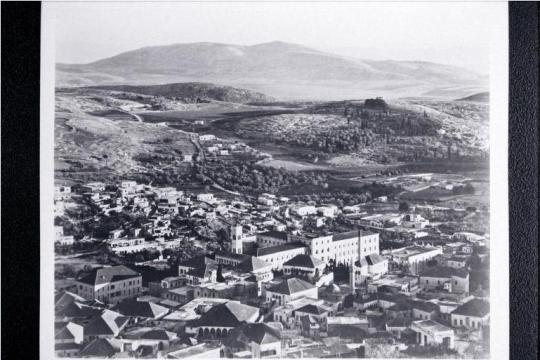
Israel. Black and white photograph. Albert Salomon Collection, Leo Baeck Institute.
In celebration of Yom Ha'atzmaut (Israel Independence Day):
two books and an archival collection, relating to Israel,
from each of our five partners.
compiled by David P. Rosenberg, M.P.A., Senior Reference Librarian - Collections, Center for Jewish History
American Jewish Historical Society:
Attitudes of American Jews toward Israel and Israelis : the 1983 national survey of American Jews and Jewish communal leaders
Current Israeli attitudes toward American Jews : contexts, problems, and recommendations
MACHAL [Mitnadvei Hutz LaAretz] and Aliyah Bet. Title MACHAL [Mitnadvei Hutz LaAretz] and Aliyah Bet Records. “The MACHAL, the acronym for “Mitnadvei Hutz LaAretz” (“Volunteers from Abroad”), consisted of about 3500 men and women from over 40 countries from a variety of social and religious backgrounds who volunteered to fight for the establishment of Israel.” Finding aid available online; click here.
American Sephardi Federation
Ancient towns in Israel
Thanksgiving prayers and readings : on the 11th Independence Day of the State of Israel
Papers of Victor D. Sanua, Containing, in part, memorial books for Israeli soldiers, research on various Jewish topics, mainly the Jewish community of Egypt, the Middle East and Israel.
Leo Baeck Institute
Zionist writings essays and addresses -Theodor Herzl
Chaim Weizmann : statesman of the Jewish renaissance : the Chaim Weizmann centenary
Franklin D. Roosevelt Collection - Memorandum of conversation between Franklin D. Roosevelt and King Ibn Saud concerning Zionism
YIVO Institute for Jewish Research
The Jewish national fund (Keren Kayemeth Leisrael Ltd.) : its history, function and activity
Conference on the Early History of Zionism in America
Labor Zionist Organization of America - Poale Zion Collection
Yeshiva University Museum
The Israelis : photographs of a day in May / by Amos Elon and 55 photographers
Israel’s money and medals
Papers of Kathryn M. Yochelson (1906- ) 1910 1948-2000. Papers collected by Kathryn Yochelson on Israeli art and artists.
Click here to conduct your own search of the collections.
10 notes
·
View notes
Text
#JewsInSpace Launches at the Center for Jewish History!
Join the Center for Jewish History and YIVO Institute for Jewish Research on a quest to examine the #Jewish exploration of the heavens as we present our new exhibition:

From as early as Genesis, Jews have pondered the expanse that surrounds our planet, as well as their place in them. Astronomy, mathematics, and other sciences appear frequently in books published by rabbis and scholars in Hebrew and other languages during the 17th-19th centuries.
By the 20th century, Jewish astronauts and cosmonauts had successfully orbited the Earth and began to explore the very heavens their ancestors studied. As Jewish writers and filmmakers embraced these achievements (and other fantastic possibilities) on the screen and the page, science fiction and pop culture were changed for generations to come.
Jews In Space brings together dozens of out-of-this-world artifacts highlighting the indispensable contributions of Jewish scientists, astronomers, explorers, writers, and entertainers, including:
Rare 18th and 19th-century rabbinic tomes on astronomy in Hebrew, German, and Yiddish
Judaica taken aboard the Space Shuttle by Astronaut Dr. Jeffrey Hoffman
Yiddish, English, Polish, and Russian works of science fiction
Rare science fiction periodicals
Stay tuned throughout May for additional events, including:
Stardate 04.15.2018–All ages family program, with arts, crafts, and curator-led tours
Stardate 05.06.2018–All ages family fun program starting before the Center opens! We’ll be offering special sensory-specific fun and activities in a calm, crowd-free environment.
Stardate 05.07.2018–Meet five-time Space Shuttle astronaut Jeffrey Hoffman and listen to him discuss his experiences as a Jew in orbit! Hoffman will be joined by Dr. Valerie Neal, curator of the Smithsonian National Air and Space Museum, who will provide an overview of the history of Jewish astronauts and their achievements in space.
Are you the leader of a #GirlScouts troop or other youth group that would like to earn a special #JewsInSpace badge for exploring the stars?
The Center would love to take your aspiring astronauts on a tour through the solar system! Email [email protected] to plan a group visit.
For artifact sneak-peeks, external reviews/coverage, and additional event announcements, search for #JewsInSpace on Instagram and Twitter!
Jews In Space: Members of the Tribe In Orbit is proudly co-presented by the Center for Jewish History & YIVO Institute for Jewish Research and financially supported by the generosity of Lisa and Joshua Greer, Kepco, Inc. & the Kupferberg Foundation.
88 notes
·
View notes
Photo
As we reflect on the 50th anniversary of the assassination of Martin Luther King Jr. we invite you to take a fresh look at this blog post reflecting on the March on Washington for Jobs and Freedom.
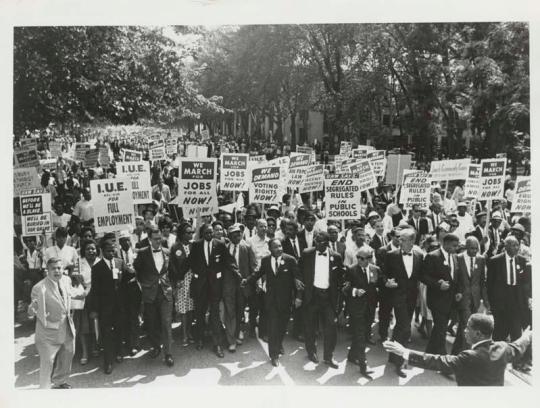
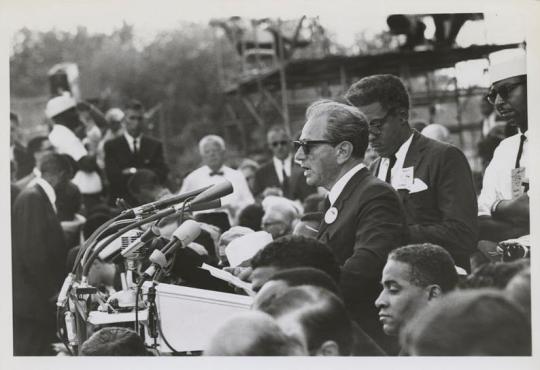
Reflecting on the March on Washington for Jobs and Freedom—
50 years ago today
by David P. Rosenberg, M.P.A., Reference Services Research Coordinator, Center for Jewish History
Rabbi Uri Miller, president of the Synagogue Council of America, recited a prayer during the March on Washington in 1963. It included:
Thou [G-d] hast endowed all men equally with the rights to live, to liberty and to the pursuit of happiness…Enable us to understand that our society, the American people is of one piece. That when any part of this society suffers we all suffer.
A video of the entire prayer can be found here.
The day after the March on Washington, Rabbi Miller reflected in a letter:
I appreciated Dr. Nathan Lander’s [Director of Research of the Synagogue Council of America] presence in Washington and his help to me personally. However I do want to say that our public relations job in Washington was not of the best…
The nature of our work is such that public relations plays a very important part and I think we ought to place it on the agenda of our Executive Committee meeting in September.
The letter is preserved in Box 20, Folder 23 of the Synagogue Council of America records held by the American Jewish Historical Society (call number I-68) here at the Center. The finding aid is available here.
The minutes of the executive committee meeting that Rabbi Miller mentioned are held in Box 7, Folder 2. The document is from Wednesday, September 11, 1963 and notes that “Rabbi Hiat [executive Vice President of the Synagogue Council of America] and Dr. Lander reported of the SCA participation in the march in Washington.”
I found the minutes from the preceding meeting on August 15, 1963 more interesting:
SCA Participation in the August 28th march on Washington: Rabbi Hiat spoke on the march on Washington stating that our testimony in Washington puts us into the position of saying that we approve of this march on Washington and our constituent agencies are participating. Rabbi Hiat said that he personally feels that we should ask our colleagues, rabbis and our congregational bodies for those who cannot be in Washington on the 28th to take time out for prayer and meditation whether in the House of Worship or privately on this day. Mr. Laub added that the Philadelphia Board of Rabbis has chartered a bus for its participants in the march. He said that he just received a letter this morning that one of our leading congregations in Washington, Adas Israel, has opened its doors, at the request of the Urban League and the Jewish Community council in Washington and the United Synagogue, to marchers who may need accommodations – dormitory accommodations. The same action was requested of all Jewish congregations in Washington. Mr. Laub said that USA [United Synagogue of America] is carrying a banner and that the SCA should do the same and issue a statement. A motion was made to endorse the march, participate if possible and issue a statement with the permission of the RCA [Rabbinical Council of America]. Rabbi Adams explained that the RCA was holding its first executive meeting for the summer the following Thursday. Rabbi Regner said that there has been so much publicity that this will be a non-violent demonstration. It was suggested that we should, in an indirect fashion, mention in our statement to keep this a non-violent demonstration. The motion was passed for the SCA to endorse the march.
There are also photos of Rabbi Miller in Washington, giving the prayer and seated near Martin Luther King Jr. by the Lincoln memorial, in Box 45 Folder 9 of the Synagogue Council of America collection.
American Jewish Congress president, Rabbi Joachim Prinz, also spoke at the march. He immediately preceded Martin Luther King Jr.
The Center partners have many books written by Rabbi Prinz. the Leo Baeck Institute also holds the Joachim Prinz Collection, AR 740. This material has been digitized and is available here.
There are also photographs of Rabbi Prinz, including some with Martin Luther King Jr., such as these photos (here and here) from the American Jewish Congress collection held by the AJHS.
For more information on Jews and the civil rights movement, you can see my blog post on it here.
The Center for Jewish History is also home to additional resources that can help us gain a broader perspective on events affecting modern Jewish life. Explore our collections at search.cjh.org or send an inquiry.
Above photos:
March on Washington for Jobs and Freedom, Martin Luther King, Jr. and Joachim Prinz pictured, 1963. from the collections of the AJHS here at the Center. (American Jewish Congress records, undated, 1916-2006. Call Number: I-77, Box 743, Folder 26, Photograph 004.)
Joachim Prinz speaking at March on Washington, with Bayard Rustin pictured, 1963. from the collections of the AJHS here at the Center. (American Jewish Congress records, undated, 1916-2006. Call Number: I-77, Box 743, Folder 26, Photograph 005)
52 notes
·
View notes
Text
Join the Center for Jewish History and the U.S. Holocaust Memorial Museum for a Research Sprint!
In collaboration with #HistoryUnfolded: U.S. Newspapers and the Holocaust, a program of the United States Holocaust Memorial Museum (USHMM), CJH will be hosting a ‘Research Sprint’-- a day for Citizen Historians to conduct research in newspaper collections and investigate U.S. press coverage for specific Holocaust events in 1938 on March 18, 2018.
Data that is uncovered for this project helps the USHMM to discover what Americans knew and how they responded to nationally/locally published news of Nazi persecution.

Participants of this event can submit their local findings to the USHMM’s online database which will be available to anyone, anywhere—from historians to curators to students.
Would you like to join us and become a Citizen Historian? Here’s what to do!
CJH TO-DOs
Register for our event on March 18, 2018 by emailing [email protected]. You will soon receive an email with more details and assigned research topics.
Register as a Researcher with CJH’s Library, by visiting libraryservices.cjh.org/aeon and creating a user account. In the Research Topic field, please fill-in “USHMM Research Sprint.”
Read through our #HistoryUnfolded LibGuide for more information!
USHMM TO-DOs
Register with #HistoryUnfolded by visiting https://newspapers.ushmm.org/auth/register, and join the “Center for Jewish History” Group to contribute to our research sprints!
Choose the event(s) selected for this research sprint listed in the initial confirmation email received from CJH.
Frequently Asked Questions:
Seems like your computer stations are limited. Can I bring my laptop instead?
You bet! We’ll help you sign on to the Center’s wi-fi and you’ll have the same access to our databases as the computer stations.
I can’t make it to the Center. Can I research from home?
Sure! Just be aware that your access to our on-site databases will be limited. For a list of other databases that provide access off-site, please visit our #HistoryUnfolded LibGuide: http://bit.ly/2oS8FXN
3 notes
·
View notes
Text
#JewsInSpace Launches at the Center for Jewish History!
Join the Center for Jewish History and YIVO Institute for Jewish Research on a quest to examine the #Jewish exploration of the heavens as we present our new exhibition:

From as early as Genesis, Jews have pondered the expanse that surrounds our planet, as well as their place in them. Astronomy, mathematics, and other sciences appear frequently in books published by rabbis and scholars in Hebrew and other languages during the 17th-19th centuries.
By the 20th century, Jewish astronauts and cosmonauts had successfully orbited the Earth and began to explore the very heavens their ancestors studied. As Jewish writers and filmmakers embraced these achievements (and other fantastic possibilities) on the screen and the page, science fiction and pop culture were changed for generations to come.
Jews In Space brings together dozens of out-of-this-world artifacts highlighting the indispensable contributions of Jewish scientists, astronomers, explorers, writers, and entertainers, including:
Rare 18th and 19th-century rabbinic tomes on astronomy in Hebrew, German, and Yiddish
Judaica taken aboard the Space Shuttle by Astronaut Dr. Jeffrey Hoffman
Yiddish, English, Polish, and Russian works of science fiction
Rare science fiction periodicals
Stay tuned throughout May for additional events, including:
Stardate 04.15.2018--All ages family program, with arts, crafts, and curator-led tours
Stardate 05.06.2018--All ages family fun program starting before the Center opens! We’ll be offering special sensory-specific fun and activities in a calm, crowd-free environment.
Stardate 05.07.2018--Meet five-time Space Shuttle astronaut Jeffrey Hoffman and listen to him discuss his experiences as a Jew in orbit! Hoffman will be joined by Dr. Valerie Neal, curator of the Smithsonian National Air and Space Museum, who will provide an overview of the history of Jewish astronauts and their achievements in space.
Are you the leader of a #GirlScouts troop or other youth group that would like to earn a special #JewsInSpace badge for exploring the stars?
The Center would love to take your aspiring astronauts on a tour through the solar system! Email [email protected] to plan a group visit.
For artifact sneak-peeks, external reviews/coverage, and additional event announcements, search for #JewsInSpace on Instagram and Twitter!
Jews In Space: Members of the Tribe In Orbit is proudly co-presented by the Center for Jewish History & YIVO Institute for Jewish Research and financially supported by the generosity of Lisa and Joshua Greer, Kepco, Inc. & the Kupferberg Foundation.
#jewish culture#jewsinspace#space#space history#jewishhistory#judaica#museumexhibition#YIVO Institute for Jewish Research Collections#yivo institute for jewish research#centerforjewishhistory#museums#archives#libraries#stem#space travel#women in stem#howdoyoumuseum
88 notes
·
View notes
Text
#1Lib1Ref

This week, CJH Archivists participated in #1Lib1Ref, a collaborative Wikipedia
project encouraging all information professionals around the country to edit one page, add at least one new link or citation, or start a brand new page to further the reach of their archival holdings.
Here's a breakdown of the amazing CJH partner collections that are now immeasurably more accessible thanks to their efforts!:
Georg Simmel
Simmel was a sociologist and philosopher, born 1858 in Berlin. Included in his collection are transcripts of personal letters to Edmund Husserl (1905-1918) and transcripts of personal correspondence between Simmel and Rainer Maria Rilke (1898-1915). Of particular interest in this collection is a handwritten letter from Simmel to Gertrud Kantorowicz dated May 20, 1918, in which he discusses his disillusionment with World War I and the hope he sees in the future of a new intellectual youth movement in Germany.
Learn more from LBI: Georg Simmel Collection, 1896-1918
Greater New York Conference on Soviet Jewry
The Greater New York Conference on Soviet Jewry (GNYCSJ) was formed in 1971 by the Federation of Jewish Philanthropies and the United Jewish Appeal of Greater New York, to address the need for an organization that would be devoted exclusively to the problems of Soviet Jewry. The GNYCSJ served as the coordinating body of Soviet Jewry activities for more than 85 constituent Jewish organizations and community groups through the New York metropolitan area, with the affiliates in the Orthodox, Conservative, and Reform Jewish communities.
Learn more from AJHS: Guide to the Greater New York Conference on Soviet Jewry collection, 1964-1990, 2016
Freedom Sunday for Soviet Jews
Freedom Sunday for Soviet Jews was the title of a national march and political rally that was held on December 6, 1987 in Washington, D.C. Posters from the rally have been digitized and are available online from the Archives of the American Soviet Jewry Movement held by AJHS.
Learn more from AJHS: Guide to the Greater New York Conference on Soviet Jewry collection, 1964-1990, 2016
Malcolm Hoenlein
Malcolm Hoenlein has been the executive vice chairman of the Conference of Presidents of Major American Jewish Organizations since June 1986. He is the founding executive director of the Greater New York Conference on Soviet Jewry and the Jewish Community Relations Council of New York.
Learn more from AJHS: Guide to the Greater New York Conference on Soviet Jewry collection, 1964-1990, 2016
Dinah Shtettin
Dinah Shtettin was a chorus girl from an Orthodox Jewish family who married the actor Jacob P. Adler in 1887. Although their marriage was short-lived, the couple had a daughter--Celia Adler.
This collection contains the personal and professional papers of Celia Adler and Lazar Freed, including theatrical materials such as scripts, programs and sheet music, correspondence, newspaper clippings, assorted publications, and photographs of many of the members of the Adler family and their friends from the Yiddish theater. These materials reflect the wide scope of the Adler acting family and their immense influence on Yiddish theater, Broadway and motion pictures.
Learn more from AJHS: Adler Family Papers, 1893-1992 (bulk 1920-1977)
Ita Aber
Ita Aber has been a New York artist, conservator, historian and curator for over three decades. Her works can be found in private and museum collections in the U.S. and Israel.
Learn more from YUM: Various museum object holdings
HIAS
HIAS began over 130 years ago as an organization dedicated to provide relocation assistance to persecuted Jews around the world. The organization’s mission now includes administering assistance to refugees and immigrants of ALL backgrounds by reuniting families and offering resettlement services through cultural and governmental advocacy.
Archivists from AJHS and the Center for Jewish History, with generous funding from HIAS, are currently working on a 3-year archival processing project to organize and provide access to thousands of digital organizational photographs, HIAS’ paper Administrative files (1950s-2000s), and limited digital access to hundreds of HIAS client files.
Learn more from AJHS: HIAS Institutional Records Archival Processing Project and its companion blog OnTheRescueFront
#Out of the Archives#library#archives#1lib1ref#American Jewish History#Leo Baeck Institute#yeshiva university museum#AJHS Collections#LBI Collections#Yeshiva University Museum Collections
5 notes
·
View notes
Text
From our Partner the American Jewish Historical Society
Saving the Syrian Jewish Brides
Our HIAS Archives Team writes a blog post every week about the amazing objects and stories they came upon while processing this important collection. Two weeks ago, Rachel Harrison, one of our HIAS project archivists, wrote this exceptional piece:
In June 1977, President Hafez el-Assad of Syria approved a plan where 12 young Jewish women would take part in proxy marriages to members of the Syrian Jewish community of Brooklyn, whom the women had never met, after which they would be allowed to emigrate to the United States. This decision came after months of secret negotiations with Representative Stephen J. Solarz, whose congressional district covered the Ocean Parkway and Midwood sections of Brooklyn, where approximately 25,000 Jews of Syrian background lived at the time, as well as a personal plea to Assad by President Carter, which also was made at the bequest of Solarz.
After Syrian independence from France in 1946, the 1947 Partition Plan, and the 1948 founding of Israel, Jews in Syria faced terrible discrimination, including several deadly pogroms and riots. By the time of the Six-Day War in 1967, there were an estimated 5,000 Jews in Syria, down from 40,000-45,000 Jews in 1948. Jews could not work for the government or banks, own telephones or driver’s licenses, Jewish property and passports were seized, bank accounts were frozen, Jewish schools were closed, and the Jewish cemetery in Damascus was paved over. A 1964 law restricted Jews from traveling more than 5 kilometers from their hometowns. Jews who were allowed to leave for medical or business reasons had to leave behind money and family members as collateral. The three largest Jewish communities, in Damascus, Aleppo, and Kamishli, were placed under house arrest for eight months following the Six-Day War. Jews began escaping in secret, sometimes with help from abroad, even though the penalty for attempting to escape or helping someone to escape was either imprisonment with hard labor or death and any family members left behind could be imprisoned. Most of those who escaped were young single men, who wanted to be free to leave at short notice. As a result, by 1977, there were 500 unmarried Jewish women in their late teens and early 20s who had no marriage prospects within the Jewish community and who were not allowed to marry non-Jews.
Representative Solarz traveled to Damascus in December 1976, where he spoke with Jewish leaders as well as Syrian government officials. The Jewish community asked that Solarz help bring the young women to his district in Brooklyn, because of the strong Syrian Jewish community. Certain Syrian government officials told him they were sympathetic to letting the women leave, as long as they did not go Israel. Back in Brooklyn, Solarz contacted local Syrian Jews who started to raise funds and look for eligible young men, as well as staff from HIAS and NYANA (New York Association for New Americans), who helped find private homes for the women to stay in, where their “husbands” could visit, and set up English-language classes and jobs for the women.
Secretary of State Cyrus R. Vance spoke with President Assad about the young women in February and in May 1977, National Security Advisor Zbigniew Brzezinski put Congressman Solarz in touch with President Carter, who then made a personal plea to the Syrian president in May. Assad eventually agreed to let 12 women leave through proxy marriages. Syrian yeshiva students from Brooklyn sent marriage proposals in June and in early July, Stephen Shalom and Michael Lewin, Solarz’s chief of staff, went to Damascus. The weddings occurred on July 19, 1977, and were conducted by the rabbi in the Damascus synagogue. Michael Lewin stood in for the absent grooms. At the same time, two other women were married in person to Americans who had come to Syria looking for wives. More than 500 people were present in the synagogue.
Please check out the HIAS project blog, On the Rescue Front, to learn more about the fascinating history of this exceptional organization.
48 notes
·
View notes
Photo

Look Who’s Coming to Dinner!
Karikatūrah Mipaām ⚫ קָרִיקָטוּרָה מִפַּעַם
Today’s cartoon in Yiddish appeared 1906 in New York in דיא ווארהייט. This newspaper in particular and others are made available online by the National Library of Israel on the website Historical Jewish Press – עיתונות יהודית היסטורית
Microfilmed and print copies of newspapers and other material are available at the Center for Jewish History. Library and archive records can be found in our catalog.
J.D. Arden is a Reference and Genealogy Librarian at CJH where he curates and translates historical Jewish cartoons for this series Karikatūrah Mipaām ⚫ קָרִיקָטוּרָה מִפַּעַם on the 16th Street Blog and our social media platforms.
@cjewishhistory on Twitter | CenterforJewishHistory on Facebook | @CenterforJewishHistory on Instagram | Blog 16thstreet.tumblr.com
Karikatūrah (קָרִיקָטוּרָה): Hebrew; Comics (American English); from Italian caricatura; a deliberately exaggerated pictorial representation to produce a comic effect. Mipaām (מִפַּעַם): Hebrew; meaning “of long ago” or “from time.”
#j.d. arden#cartoons#comics#yiddish#cartoon series#KarikaturahMipaam#קריקטורהמפעם#translated Jewish cartoons
3 notes
·
View notes
Photo
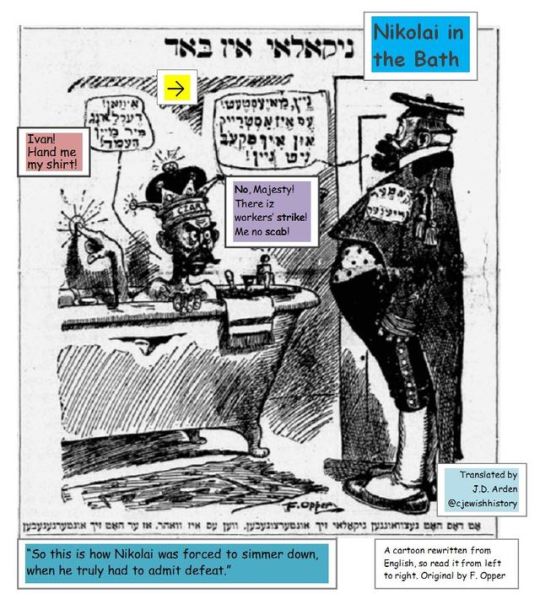
How the Czar Takes a Bath…
Karikatūrah Mipaām ⚫ קָרִיקָטוּרָה מִפַּעַם
Today’s cartoon in Yiddish appeared 1905 in New York in דיא ווארהייט. This newspaper in particular and others are made available online by the National Library of Israel on the website Historical Jewish Press – עיתונות יהודית היסטורית
Microfilmed and print copies of newspapers and other material are available at the Center for Jewish History. Library and archive records can be found in our catalog.
J.D. Arden is a Reference and Genealogy Librarian at CJH where he curates and translates historical Jewish cartoons for this series Karikatūrah Mipaām ⚫ קָרִיקָטוּרָה מִפַּעַם on the 16th Street Blog and our social media platforms.
@cjewishhistory on Twitter | CenterforJewishHistory on Facebook | @CenterforJewishHistory on Instagram | Blog 16thstreet.tumblr.com
Karikatūrah (קָרִיקָטוּרָה): Hebrew; Comics (American English); from Italian caricatura; a deliberately exaggerated pictorial representation to produce a comic effect. Mipaām (מִפַּעַם): Hebrew; meaning “of long ago” or “from time.”
#J.D. Arden#Cartoons#comics#cartoon series#yiddish#KarikaturahMipaam#קריקטורהמפעם#translated Jewish cartoons
2 notes
·
View notes
Photo

Missing in Action…
Karikatūrah Mipaām ⚫ קָרִיקָטוּרָה מִפַּעַם
Today’s cartoon in Hebrew appeared in Israel in 1943 in על המשמר. This newspaper in particular and others are made available online by the National Library of Israel on the website Historical Jewish Press – עיתונות יהודית היסטורית
Microfilmed and print copies of newspapers and other material are available at the Center for Jewish History. Library and archive records can be found in our catalog.
J.D. Arden is a Reference and Genealogy Librarian at CJH where he curates and translates historical Jewish cartoons for this series Karikatūrah Mipaām ⚫ קָרִיקָטוּרָה מִפַּעַם on the 16th Street Blog and our social media platforms.
@cjewishhistory on Twitter | CenterforJewishHistory on Facebook | @CenterforJewishHistory on Instagram | Blog 16thstreet.tumblr.com
Karikatūrah (קָרִיקָטוּרָה): Hebrew; Comics (American English); from Italian caricatura; a deliberately exaggerated pictorial representation to produce a comic effect. Mipaām (מִפַּעַם): Hebrew; meaning “of long ago” or “from time.”
#J.D. Arden#cartoons#comics#cartoon series#Hebrew#KarikaturahMipaam#קריקטורהמפעם#translated Jewish cartoons
1 note
·
View note
Photo
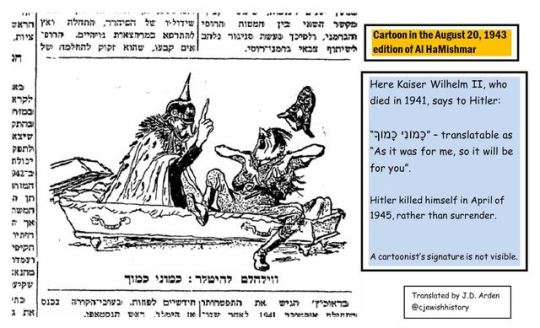
Lessons of History…
Karikatūrah Mipaām ⚫ קָרִיקָטוּרָה מִפַּעַם
Today’s cartoon in Hebrew appeared in Israel in 1943 in על המשמר. This newspaper in particular and others are made available online by the National Library of Israel on the website Historical Jewish Press – עיתונות יהודית היסטורית
Microfilmed and print copies of newspapers and other material are available at the Center for Jewish History. Library and archive records can be found in our catalog.
J.D. Arden is a Reference and Genealogy Librarian at CJH where he curates and translates historical Jewish cartoons for this series Karikatūrah Mipaām ⚫ קָרִיקָטוּרָה מִפַּעַם on the 16th Street Blog and our social media platforms.
@cjewishhistory on Twitter | CenterforJewishHistory on Facebook | @CenterforJewishHistory on Instagram | Blog 16thstreet.tumblr.com
Karikatūrah (קָרִיקָטוּרָה): Hebrew; Comics (American English); from Italian caricatura; a deliberately exaggerated pictorial representation to produce a comic effect. Mipaām (מִפַּעַם): Hebrew; meaning “of long ago” or “from time.”
#j.d. arden#cartoons#comics#cartoon series#Hebrew#KarikaturahMipaam#קריקטורהמפעם#TranslatedJewishCartoons#translated Jewish cartoons
3 notes
·
View notes
Photo
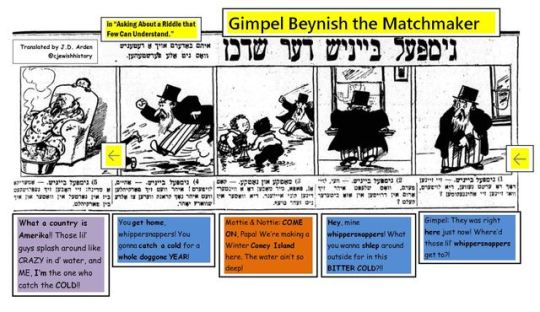
When the Matchmaker Has Kids...
Karikatūrah Mipaām ⚫ קָרִיקָטוּרָה מִפַּעַם
Today’s cartoon in Yiddish appeared January, 1915 in New York in דיא ווארהייט. This newspaper in particular and others are made available online by the National Library of Israel on the website Historical Jewish Press – עיתונות יהודית היסטורית
Microfilmed and print copies of newspapers and other material are available at the Center for Jewish History. Library and archive records can be found in our catalog.
J.D. Arden is a Reference and Genealogy Librarian at CJH where he curates and translates historical Jewish cartoons for this series Karikatūrah Mipaām ⚫ קָרִיקָטוּרָה מִפַּעַם on the 16th Street Blog and our social media platforms.
@cjewishhistory on Twitter | CenterforJewishHistory on Facebook | @CenterforJewishHistory on Instagram | Blog 16thstreet.tumblr.com
Karikatūrah (קָרִיקָטוּרָה): Hebrew; Comics (American English); from Italian caricatura; a deliberately exaggerated pictorial representation to produce a comic effect. Mipaām (מִפַּעַם): Hebrew; meaning “of long ago” or “from time.”
1 note
·
View note
Photo
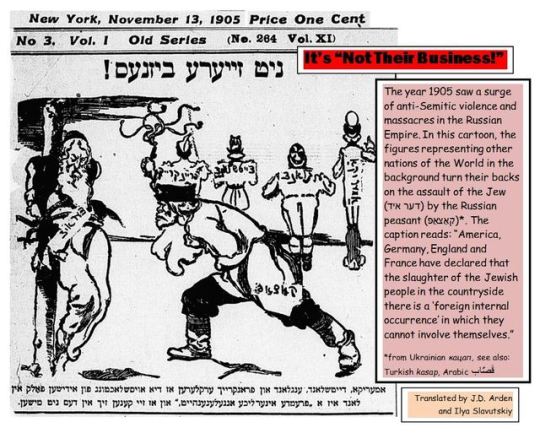
It’s “Not Their Business!”
Karikatūrah Mipaām ⚫ קָרִיקָטוּרָה מִפַּעַם
Today’s cartoon in Yiddish appeared 1905 in דיא ווארהייט. This newspaper in particular and others are made available online by the National Library of Israel on the website Historical Jewish Press – עיתונות יהודית היסטורית
Microfilmed and print copies of newspapers and other material are available at the Center for Jewish History. Library and archive records can be found in our catalog.
J.D. Arden is a Reference and Genealogy Librarian at CJH where he curates and translates historical Jewish cartoons for this series Karikatūrah Mipaām ⚫ קָרִיקָטוּרָה מִפַּעַם on the 16th Street Blog and our social media platforms.
@cjewishhistory on Twitter | CenterforJewishHistory on Facebook | @CenterforJewishHistory on Instagram | Blog 16thstreet.tumblr.com
Karikatūrah (קָרִיקָטוּרָה): Hebrew; Comics (American English); from Italian caricatura; a deliberately exaggerated pictorial representation to produce a comic effect. Mipaām (מִפַּעַם): Hebrew; meaning “of long ago” or “from time.”
#j.d. arden#comics#cartoon series#yiddish#cartoons#KarikaturahMipaam#קריקטורהמפעם#translated Jewish cartoons
1 note
·
View note
Photo
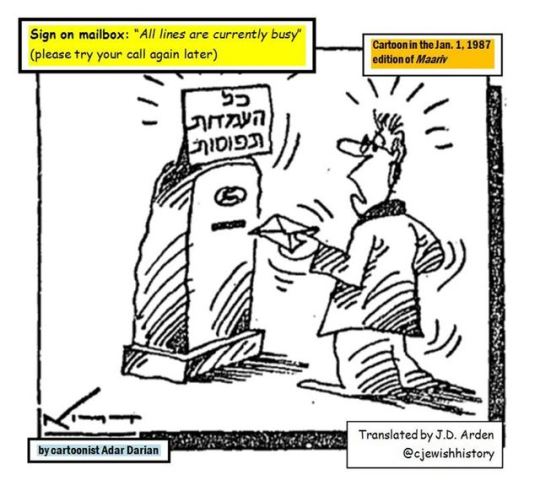
Out of Order...
Karikatūrah Mipaām ⚫ קָרִיקָטוּרָה מִפַּעַם
Today’s cartoon in Hebrew appeared 1987 in מעריב. This newspaper in particular and others are made available online by the National Library of Israel on the website Historical Jewish Press – עיתונות יהודית היסטורית
Microfilmed and print copies of newspapers and other material are available at the Center for Jewish History. Library and archive records can be found in our catalog.
J.D. Arden is a Reference and Genealogy Librarian at CJH where he curates and translates historical Jewish cartoons for this series Karikatūrah Mipaām ⚫ קָרִיקָטוּרָה מִפַּעַם on the 16th Street Blog and our social media platforms.
@cjewishhistory on Twitter | CenterforJewishHistory on Facebook | @CenterforJewishHistory on Instagram | Blog 16thstreet.tumblr.com
Karikatūrah (קָרִיקָטוּרָה): Hebrew; Comics (American English); from Italian caricatura; a deliberately exaggerated pictorial representation to produce a comic effect. Mipaām (מִפַּעַם): Hebrew; meaning “of long ago” or “from time.”
#j.d. arden#cartoons#comics#cartoon series#hebrew#karikaturahmipaam#קריקטורהמפעם#translated Jewish cartoons
4 notes
·
View notes
Text
How to Gellan?
by Kat Fanning, Preservation Associate at the Center for Jewish History
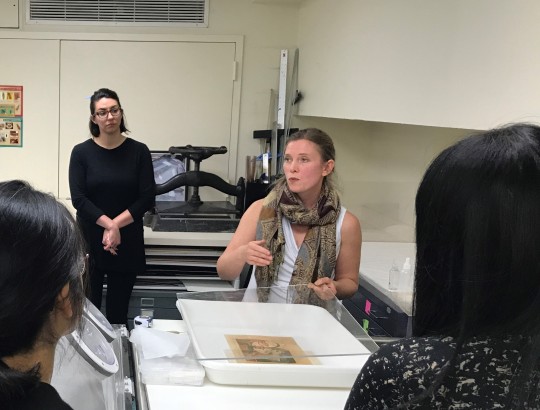
The first time that I started to take notice of the multitude of possibilities that applications of gellan was capable of was at my very first AIC conference in 2016, the 44th annual meeting in Montreal, Quebec. I’ve been waiting to test its potential ever since. And on Thursday, November 30th, I finally got to test it out!
Preservation Services Manager, Jennifer Sainato, in the Cahnman Preservation Laboratory at the Center for Jewish History arranged to host a gellan gum workshop with Heather Hendry of the Conservation Center for Art & Historic Artifacts. We had participants from many institutions; Yale, NYAM, NYHS, Brooklyn College, Cooper Hewitt, etc.
A quick note on gellan -
“Gellan is a rigid polysaccharide gel with a wide range of uses in conservation. Gellan is used at CCAHA for washing items with water sensitive media; stain reduction; removal of backings, tapes, and adhesive residues; solvent delivery; and application of chelating agents. Through presentations, demonstrations, and hands-on activities, participants will collaboratively explore the wide potential of gellan treatments.“
Heather guided us through a brief overview of gellan and some of its applications. Different concentrations are useful for different things. For example, a ~3.5% gel application is a good way to introduce moisture slowly to a broad range of materials. A 5% gel is fantastic for various treatment of very water sensitive material.
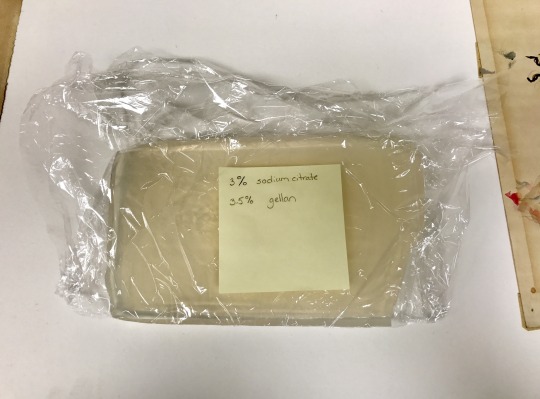
Then we learned how to make it. It is a relatively simple process, utilizing the microwave. It is possible to make varying thicknesses and concentrations of gellan for different applications. Just be sure that if you are using the break room microwave, that it is not around lunch time.
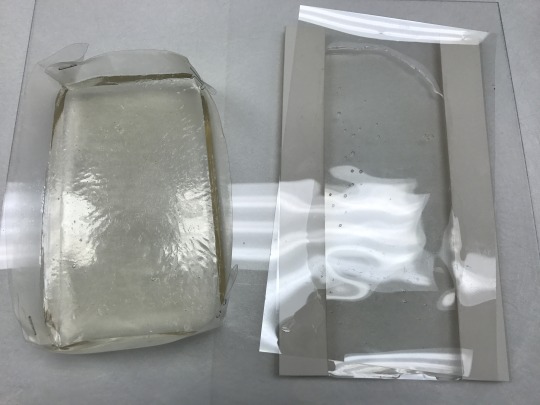
Finally, we were able to experiment with the samples that Heather was kind enough to bring with her. Tape removal is always fun *sarcasm*.[1] Every conservation professional should have an arsenal of removal methods for the hundreds of types of tape available in the world. In this workshop, we experimented with various kinds of tape with water soluble adhesive. Previously to this workshop, I usually use a combination of SCMC, heat, and/or water to remove water soluble adhesive. Sometimes it is very difficult. Participants were even able to significantly reduce dark water staining from book cloth on a bound volume. Unlike SCMC, there is also no shiny residue left behind that needs to be cleaned.
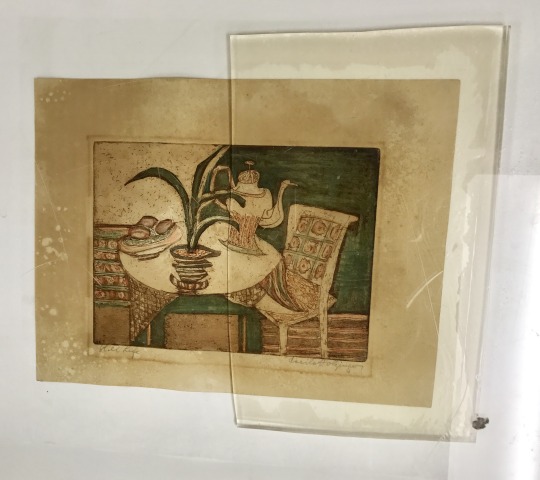
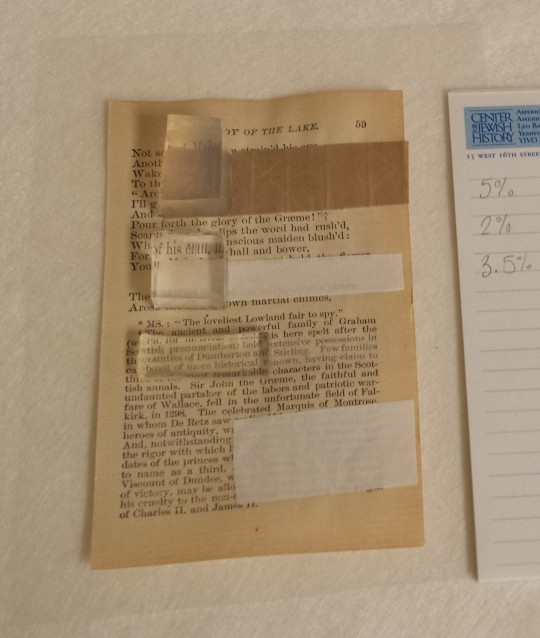
My takeaways from the workshop were that:
1. Preparation is not as difficult as it seems. Just be sure to use metric to make life easy!
2. The use of gellan is a fantastic tool to keep in the toolbox for
a. slow introduction of moisture or solvent
b. great and simple method for removing water soluble adhesive.
Thanks to the generous assistance of the Center for Art and Historic Artifacts and the the Center for Jewish History for hosting this hands-on workshop for local paper conservators. We in the Gisela and Levi Cahnman Preservation Laboratory at the Center for Jewish History look forward to hosting future workshops for conservation professionals. For more information, please email us at [email protected]. Be sure to follow our instagram: https://www.instagram.com/centerforjewishhistory/
[1] I only know that time travel is not possible in my lifetime because if it had been, I would have traveled back in time and prevented so much tape application!
3 notes
·
View notes